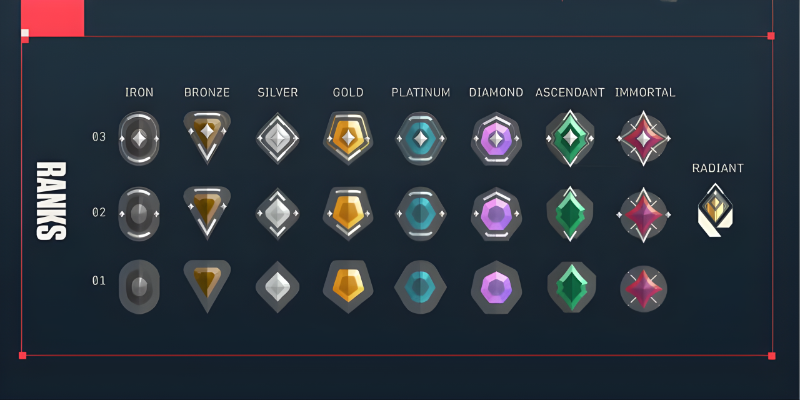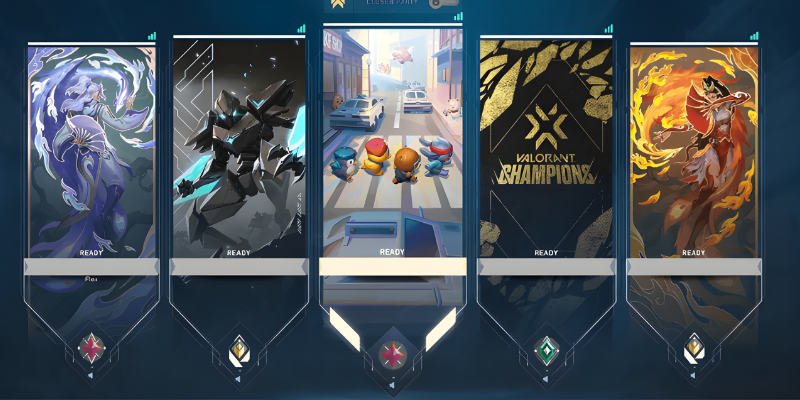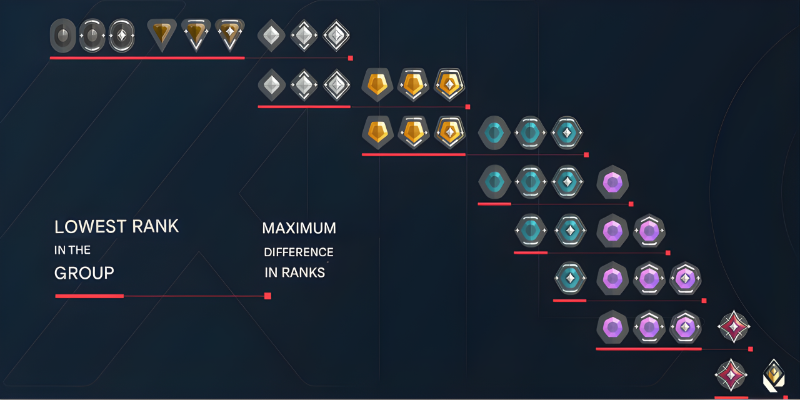Welcome to Boosting Ground's definitive guide to understanding Valorant's competitive ranking system. Whether you're a newcomer struggling to grasp the intricacies of ranked play or an experienced player looking to optimize your climb, this comprehensive breakdown will equip you with everything you need to know about how Valorant determines and adjusts your competitive standing.
Understanding Valorant's Competitive Hierarchy
Valorant employs a sophisticated nine-tier ranking structure designed to accurately represent player skill across all levels of competition. This system creates a competitive environment where progression feels meaningful while maintaining balanced matchmaking at every level.

The Nine Competitive Tiers
The competitive ladder consists of the following ranks, arranged from lowest to highest skill level:
- Iron - The entry point for most new competitive players, representing developing fundamental skills and game understanding.
- Bronze - Players demonstrating basic game mechanics and beginning to understand tactical concepts.
- Silver - Intermediate players with solid mechanical skills and growing strategic awareness.
- Gold - Above-average players showing consistent performance and tactical understanding.
- Platinum - Advanced players with strong mechanical skills and strategic thinking.
- Diamond - Highly skilled players demonstrating excellent game sense and execution.
- Ascendant - Elite players with exceptional skills approaching professional-level play.
- Immortal - Top-tier players representing the highest level of competitive play.
- Radiant - The pinnacle of competitive achievement, reserved exclusively for the top 500 players in each region.
Division Structure and Progression
Each competitive tier operates with a three-division system, creating clear progression milestones within each rank. Players advance through divisions one (the lowest) through three (the highest) before promoting to the next tier. For example, a Gold-ranked player progresses from Gold 1 to Gold 2, then Gold 3, before potentially reaching Platinum 1.
Radiant stands as the sole exception to this structure, operating as a single, exclusive tier without subdivisions. This design emphasizes Radiant's status as the ultimate competitive achievement, accessible only to the most elite players in each region.
The Dual Rating System: MMR and RR Explained
Valorant's ranking system operates on two interconnected but distinct rating mechanisms that work together to ensure accurate skill assessment and fair matchmaking.

Matchmaking Rating (MMR): Your True Skill Level
Matchmaking Rating represents your actual skill level as calculated by Valorant's algorithms. This hidden value continuously adjusts based on your performance and remains invisible to players. MMR serves as the foundation for several critical system functions:
- Opponent Selection: MMR determines the skill level of players you face in competitive matches
- Match Balance: The system uses MMR to create fair, competitive games
- Long-term Skill Tracking: MMR provides a more stable representation of your abilities over time
Rank Rating (RR): Your Visible Progress
Rank Rating functions as the visible component of your competitive standing, displaying your progress within each rank division on a scale from 0 to 100 points. This system provides immediate feedback on your competitive performance:
- Promotion Mechanics: Reaching 100 RR triggers advancement to the next division or tier
- Demotion Risk: Dropping to 0 RR may result in demotion to a lower division
- Match-by-Match Feedback: RR changes after each game, showing immediate progress or setbacks
The Interaction Between MMR and RR
The relationship between these two systems creates dynamic rank adjustment that reflects your true skill development:
Entry Requirements and Placement System
Valorant implements specific requirements before players can participate in competitive matchmaking, ensuring participants possess basic game knowledge and account investment.
Prerequisites for Competitive Play
Players must satisfy two fundamental requirements:
- Account Level 20: This requirement ensures players have sufficient unrated game experience to understand basic mechanics, maps, and agents before entering ranked play.
- Placement Match Completion: Five placement matches determine your initial competitive rank based on performance against players of varying skill levels.
Understanding Placement Matches
These initial five games serve multiple purposes in establishing your competitive foundation:
- Skill Assessment: The system evaluates your performance across various game aspects including aim, game sense, and teamwork
- Initial Rank Assignment: Your placement results directly influence your starting rank within the competitive hierarchy
- MMR Calibration: These matches help establish your initial hidden MMR value for future matchmaking
Season Structure and Rank Resets
Valorant's competitive system underwent significant changes in 2025, transitioning from the previous Episode-based structure to a more comprehensive seasonal approach.
The New Season Framework
The current system operates on year-long Seasons, each divided into six distinct Acts. This structure provides regular opportunities for rank recalibration while maintaining longer-term competitive progression.
Rank Reset Mechanics
Rank resets occur at two specific intervals:
- Season Commencement: The beginning of each new Season triggers a complete rank reset
- Mid-Season Reset: An additional reset occurs at the Season's midpoint
Following each reset, all players must complete new placement matches to reestablish their competitive rank. This system ensures the competitive landscape remains dynamic and accurately reflects current player skill levels rather than historical performance.
Party Composition and Matchmaking Impact
Valorant's matchmaking system adapts its approach based on the number of players queuing together, implementing different rules to maintain competitive integrity across various party sizes.

Solo and Duo Queue Dynamics
When playing alone or with one teammate, the matchmaking system provides the most balanced experience:
- Fair Opponent Matching: The system pairs players against others with similar MMR values
- Consistent RR Changes: Standard RR gain and loss rates apply without additional penalties
- Optimal Competitive Environment: This queue type typically offers the most accurate skill-based matchmaking
Five-Stack Considerations
Playing with a complete five-person team introduces specific adjustments to maintain competitive fairness:
- RR Penalties: The system applies RR reduction penalties to account for the coordination advantages of premade teams
- Skill Disparity Management: Additional penalties may apply when team members have significantly different skill levels
- Enhanced Coordination Benefits: While penalties exist, coordinated teams often enjoy strategic advantages that can offset RR reductions
These adjustments ensure that competitive integrity remains intact regardless of party composition, preventing exploitation of team coordination for unfair rank advancement.
Performance Factors and Behavioral Impact
Multiple elements contribute to your rank progression beyond simple win-loss records, creating a comprehensive evaluation system that rewards both individual excellence and team contribution.
Match Outcome Significance
Victory remains the most crucial factor in rank progression, but the system considers additional performance metrics:
- Primary Impact: Winning matches provides the largest positive impact on RR gains
- Performance Modifiers: Individual statistics can slightly adjust RR changes, particularly in lower ranks
- Consistency Rewards: Regular strong performance creates positive long-term MMR trends
Round Differential Effects
The margin of victory significantly influences RR gains and losses:
- Dominant Victories: Convincing wins (such as 13-3 scores) generate higher RR rewards
- Close Matches: Narrow victories or defeats result in moderate RR changes
- Performance Consistency: Maintaining strong play throughout entire matches maximizes RR potential
Individual Performance Metrics
The system evaluates various individual contributions, though their impact varies by rank tier:
- Kill/Death/Assist Ratios: These statistics influence RR changes, particularly for players in lower ranks
- Round Impact: Clutch plays, entry fragging, and support actions contribute to performance evaluation
- Agent Role Fulfillment: Playing effectively within your chosen agent's role enhances performance ratings
Behavioral Consequences
Player conduct directly affects rank progression through several mechanisms:
- Match Dodging: Leaving during agent selection can result in RR penalties and queue restrictions
- AFK Penalties: Abandoning matches negatively impacts both MMR and RR
- Report System: Receiving reports for unsportsmanlike behavior can hinder rank advancement
- Positive Behavior: Consistent good conduct supports steady rank progression
Current Competitive Landscape: 2025 Rank Distribution
Understanding where you stand relative to the broader player base provides valuable context for your competitive journey and helps set realistic progression goals.
Detailed Rank Population Breakdown
The current distribution across all competitive tiers reveals interesting patterns about player skill concentration:
| Rank Tier | Population Percentage | Skill Level |
|---|---|---|
| Iron | 6.8% | Entry-level players developing fundamentals |
| Bronze | 16.9% | Basic mechanics and tactical understanding |
| Silver | 21.6% | Intermediate players with solid mechanics |
| Gold | 22% | Above-average competitive skill |
| Platinum | 16.1% | Advanced players with strong mechanics |
| Diamond | 10.3% | Highly skilled with excellent game sense |
| Ascendant | 5% | Elite players approaching pro-level |
| Immortal | 0.88% | Top-tier competitive players |
| Radiant | 0.02% | Absolute pinnacle of competitive achievement |
Rank Concentration Analysis
This distribution reveals several important insights:
- Middle Tier Dominance: Silver and Gold tiers contain nearly 44% of all competitive players
- Progression Difficulty: Advancing beyond Gold becomes increasingly challenging, with each higher tier containing fewer players
- Elite Exclusivity: Less than 6% of players achieve Ascendant rank or higher, emphasizing the difficulty of reaching top-tier play

Strategic Approach to Rank Advancement
Successful rank climbing requires understanding how Valorant's systems work and aligning your gameplay approach with these mechanics.
Consistency as the Foundation
Regular, consistent play provides the most reliable path to rank advancement:
- Frequent Practice: Regular matches maintain and improve your mechanical skills and game sense
- Skill Maintenance: Consistent play prevents skill decay and maintains your competitive edge
- System Recognition: The ranking system rewards sustained performance over short-term peaks
Agent Specialization Strategy
Focusing your efforts on mastering a limited number of agents yields better results than spreading your attention across the entire roster:
- Deep Understanding: Mastering fewer agents allows for superior game sense and strategic thinking within those roles
- Consistent Performance: Specialized knowledge leads to more reliable performance across different maps and situations
- Team Contribution: Expertise with specific agents enables better team coordination and strategic execution
Communication Excellence
Effective team communication significantly impacts match outcomes and, consequently, rank progression:
- Strategic Coordination: Clear callouts and strategy discussion improve team decision-making
- Information Sharing: Timely enemy position updates and tactical information enhance team performance
- Positive Environment: Constructive communication maintains team morale and focus throughout matches
Behavioral Optimization
Maintaining positive behavior patterns supports consistent rank advancement:
- Penalty Avoidance: Steering clear of dodging, AFK behavior, and unsportsmanlike conduct prevents MMR and RR penalties
- Professional Conduct: Positive interactions with teammates and opponents create better match environments
- System Alignment: Working with rather than against Valorant's behavioral expectations supports progression
Continuous Improvement Methodology
Systematic approach to skill development accelerates rank advancement:
- Gameplay Review: Analyzing your matches identifies specific areas requiring improvement
- Strategic Adaptation: Adjusting your approach based on performance analysis leads to better results
- Learning Integration: Incorporating lessons from both victories and defeats into future gameplay enhances skill development
Frequently Asked Questions
Question: What happens if I win but perform terribly?
Answer: RR gains still occur for victories, but poor individual performance reduces the amount gained, particularly in lower ranks. At higher competitive tiers, exceptionally poor performance in a winning match might result in minimal or zero RR increases, as the system emphasizes both team success and individual contribution.
Question: Can I skip divisions or ranks?
Answer: Yes, rank skipping is possible when your hidden MMR significantly exceeds your current visible rank. Upon reaching 100 RR, players with sufficiently high MMR relative to their current rank can advance multiple divisions or even entire tiers. While uncommon, this mechanism ensures skilled players reach their appropriate rank more quickly.
Question: Do custom or unrated matches affect my rank?
Answer: No, only competitive matches influence your MMR and RR. Custom games and unrated matches provide safe environments for practice and experimentation without risking your competitive standing.
Question: Does dodging (leaving in agent select) affect MMR?
Answer: Match dodging doesn't directly impact MMR but creates indirect consequences. Frequent dodging results in penalties including reduced RR gains in future matches and extended queue delays. Excessive dodging triggers increasingly severe penalties from the system.
Question: Is Radiant rank the same across regions?
Answer: No, Radiant operates as a regional rank with only the top 500 players per region earning this title. A Radiant player in North America doesn't automatically hold Radiant status in Europe or other regions, and vice versa. Each region maintains its own separate Radiant leaderboard.
Conclusion
Mastering Valorant's ranking system requires understanding both its visible mechanics and hidden complexities. Success comes not just from mechanical skill but from working intelligently within the system's framework. By focusing on consistent performance, strategic agent specialization, effective communication, and positive behavior, you can optimize your climb through the competitive ranks.
Remember that rank progression is a journey requiring patience, dedication, and continuous improvement. The ranking system rewards sustained excellence over time, making consistent effort and smart gameplay choices your most valuable tools for competitive success.
At Boosting Ground, we're committed to helping you achieve your competitive goals with comprehensive guides and expert insights. Use this knowledge to inform your approach, and remember that every professional player started exactly where you are now.

